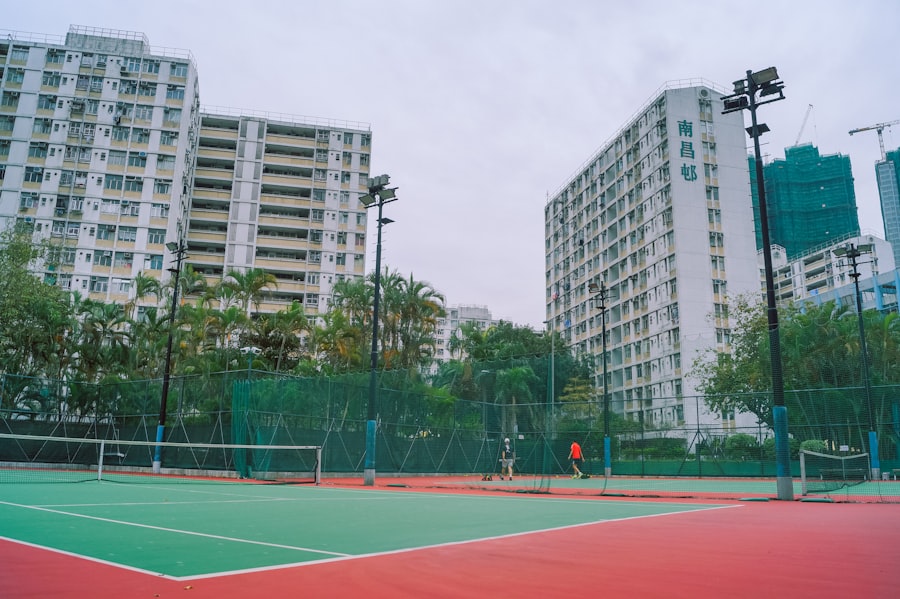Mastering the Art of Badminton: Techniques and Tips
Description
Badminton is a sport that combines agility, precision, and strategy, played on a rectangular court divided by a net. The dimensions of a standard badminton court are 13.4 meters long and 6.1 meters wide for doubles play, while the width narrows to 5.18 meters for singles matches. The net, which stands at a height of 1.55 meters at the center, creates a barrier that players must skillfully navigate to score points.
The court is marked with lines that delineate the service areas, the boundaries for singles and doubles play, and the center line that helps players position themselves during serves. Understanding these dimensions is crucial for players as they develop their spatial awareness and strategize their movements during a match. In addition to the court, the equipment used in badminton plays a significant role in the game.
The primary piece of equipment is the badminton racket, which typically weighs between 70 to 100 grams. Rackets are made from various materials, including carbon fiber and aluminum, each offering different benefits in terms of weight and durability. The strings of the racket are also essential; they can be strung at varying tensions to affect power and control.
Players must choose their rackets based on their playing style and comfort. Furthermore, the shuttlecock, or birdie, is another critical component of the game. Made from feathers or synthetic materials, shuttlecocks come in different speeds and weights, influencing how they travel through the air.
Understanding the characteristics of both the racket and shuttlecock is vital for players aiming to enhance their performance on the court.
Key Takeaways
- The badminton court is divided into halves by a net and players use rackets to hit a shuttlecock back and forth over the net.
- Essential badminton strokes include the clear, drop, smash, and drive, each with its own technique and purpose in the game.
- Improving speed and agility on the court is crucial for effective footwork and movement in badminton.
- Outsmarting your opponent in badminton involves using strategies and tactics such as varying your shots and exploiting your opponent’s weaknesses.
- Mastering the serve in badminton requires techniques for a powerful and accurate serve to gain an advantage in the game.
Mastering the Essential Badminton Strokes: Clear, Drop, Smash, and Drive
The Clear: A Fundamental Stroke
The clear is one of the most fundamental strokes, used to send the shuttlecock high and deep into the opponent’s court. Executing a clear requires proper grip and technique; players should hold the racket with a relaxed grip and use a full arm swing to generate power. A well-executed clear not only gives players time to reposition themselves but also forces opponents to move back, creating opportunities for follow-up shots.
Finesse and Power: The Drop Shot and Smash
The drop shot is another essential stroke that contrasts sharply with the clear. It is executed with finesse and precision, aimed to land just over the net in the opponent’s front court. A successful drop shot requires a delicate touch and an understanding of timing; players must disguise their intentions to catch their opponents off guard. The smash is often regarded as one of the most powerful offensive strokes in badminton. It involves hitting the shuttlecock forcefully downwards into the opponent’s court, ideally at an angle that makes it difficult to return. To perform an effective smash, players need to generate significant racket head speed and utilize their body weight to add power to the shot.
The Drive: A Fast-Paced Stroke
The drive is a fast-paced stroke that keeps the shuttlecock low over the net, making it challenging for opponents to intercept. This stroke is particularly effective in doubles play, where quick exchanges are common. Players must focus on maintaining a flat trajectory while generating speed through quick wrist movements and body positioning. By mastering these four essential strokes—clear, drop, smash, and drive—players can develop a versatile game that can adapt to various situations on the court.
Footwork and Movement: Improving Speed and Agility on the Court

Footwork is often considered one of the most critical aspects of badminton, as it directly influences a player’s ability to reach the shuttlecock effectively and execute shots with precision. Good footwork allows players to maintain balance while moving quickly around the court. The basic footwork patterns include lunges, side steps, and quick pivots, all of which help players position themselves optimally for each shot.
Practicing these movements regularly can significantly enhance a player’s agility and overall performance. To improve footwork, players can incorporate specific drills into their training routines. For instance, shadow badminton involves mimicking game movements without an actual shuttlecock, allowing players to focus on their footwork patterns without distraction.
Additionally, ladder drills can enhance coordination and speed by requiring players to navigate through a series of rungs placed on the ground. These exercises not only build muscle memory but also improve cardiovascular fitness, which is essential for sustaining energy throughout a match. Another key aspect of movement on the court is understanding how to anticipate an opponent’s shots.
Players should develop a keen sense of observation to predict where the shuttlecock will go based on their opponent’s body language and racket positioning. This anticipation allows for quicker reactions and better positioning, ultimately leading to more successful returns. By combining effective footwork with strategic movement patterns, players can significantly enhance their performance during matches.
Strategies and Tactics: How to Outsmart Your Opponent
| Strategies and Tactics | Metrics |
|---|---|
| Number of Moves | 20 |
| Success Rate | 75% |
| Time to Execute | 30 minutes |
| Resources Utilized | 3 |
In badminton, physical skill alone is not enough; strategic thinking plays a vital role in outmaneuvering opponents. One effective strategy is to exploit an opponent’s weaknesses by observing their playing style throughout the match. For instance, if an opponent struggles with high shots or has difficulty returning smashes from certain angles, players can adjust their tactics accordingly by targeting those areas consistently.
Another important tactic involves varying shot placement and speed to disrupt an opponent’s rhythm. By mixing up clears, drops, smashes, and drives, players can keep their opponents guessing and prevent them from settling into a comfortable playing pattern. Additionally, utilizing deceptive shots—where players disguise their intended shot until the last moment—can create openings for scoring opportunities.
This unpredictability forces opponents to remain alert and reactive rather than proactive. In doubles play, communication and teamwork become paramount strategies. Partners must develop an understanding of each other’s strengths and weaknesses while coordinating movements on the court.
Effective positioning allows one player to cover the front while the other covers the back, maximizing court coverage and minimizing gaps that opponents can exploit.
Mastering the Serve: Techniques for a Powerful and Accurate Serve
The serve is one of the most critical aspects of badminton as it initiates each rally and sets the tone for subsequent exchanges.
There are several types of serves in badminton: high serves, low serves, flick serves, and drive serves, each serving different tactical purposes.
The high serve is commonly used in singles play as it sends the shuttlecock deep into the opponent’s court, forcing them to move back and giving the server time to prepare for their next shot. To execute a high serve effectively, players should focus on generating height while maintaining control over direction. The low serve, on the other hand, is often employed in doubles play as it aims to land just over the net in front of the opponent’s service area.
This type of serve requires precision and finesse; players must ensure that they do not hit too high or too far. Flick serves are particularly useful when opponents anticipate a low serve; by quickly changing tactics and delivering a flick serve instead, players can catch their opponents off guard. Drive serves are powerful serves aimed directly at opponents’ bodies or at specific angles to limit their response options.
Mastering these various serving techniques allows players to keep their opponents guessing right from the start of each rally.
Improving Your Defense: Tips for Blocking and Returning Shots

Blocking: The Foundation of Defense
One fundamental defensive technique is blocking, which involves using a firm wrist position to absorb an opponent’s powerful shots while redirecting them back into play.
Improving Blocking Skills
To improve blocking skills, players should practice reaction drills that simulate fast-paced exchanges with partners or coaches. These drills help develop hand-eye coordination and quick reflexes necessary for effective blocking during matches. Additionally, practicing defensive footwork allows players to position themselves optimally when anticipating incoming shots.
Returning Shots Effectively
Returning shots effectively also requires understanding different types of returns based on shot placement and speed. For instance, when facing a smash from an opponent, players should focus on using their body weight to absorb impact while redirecting the shuttlecock back over the net with controlled power. Similarly, when returning drop shots or clears, players must be mindful of their positioning to ensure they can execute accurate returns without compromising balance.
Mental Preparation and Focus: Developing a Winning Mindset
Mental preparation is often overlooked in sports training but plays an essential role in achieving success on the badminton court. Developing a winning mindset involves cultivating focus, confidence, and resilience throughout matches. Visualization techniques can be particularly effective; players can mentally rehearse successful plays or visualize themselves executing specific strokes under pressure.
Additionally, mindfulness practices such as meditation or breathing exercises can help players maintain composure during high-stress situations on the court. By learning how to manage anxiety and stay present in each moment of play, athletes can enhance their performance significantly. Another aspect of mental preparation involves setting realistic goals for improvement—whether it’s mastering a specific stroke or enhancing overall fitness levels—players should establish measurable objectives that motivate them throughout training sessions.
Celebrating small victories along this journey fosters confidence while reinforcing positive habits essential for long-term success.
Training and Conditioning: Exercises and Drills to Improve Your Badminton Skills
To excel in badminton requires not only skill development but also physical conditioning tailored specifically for this fast-paced sport. Strength training exercises focusing on core stability are vital since they enhance balance during dynamic movements on the court. Exercises such as planks or medicine ball rotations help build core strength essential for executing powerful shots while maintaining stability.
Cardiovascular conditioning is equally important; incorporating interval training into workout routines can improve endurance levels necessary for sustaining energy throughout matches. High-intensity interval training (HIIT) sessions simulate match conditions by alternating between bursts of intense activity followed by short recovery periods—this approach enhances both aerobic capacity and anaerobic performance. In addition to strength training and cardiovascular conditioning, incorporating sport-specific drills into practice sessions is crucial for skill enhancement.
Drills focusing on footwork patterns allow players to refine their movement efficiency while improving reaction times during gameplay scenarios. Partner drills that simulate game situations help reinforce tactical understanding while providing opportunities for real-time feedback. By integrating these training elements—strength conditioning exercises tailored for badminton athletes alongside sport-specific drills—players can develop comprehensive skills necessary for success on the court while enhancing overall physical fitness levels essential for peak performance during matches.
If you’re a fan of badminton, you may also be interested in reading about the latest trends in the sport. Check out this article on word mania which discusses the mental aspect of badminton and how players can improve their game through strategic thinking and quick decision-making. This article provides valuable insights into the importance of mental agility in sports like badminton.
FAQs
What is badminton?
Badminton is a racquet sport played by either two opposing players (singles) or two opposing pairs (doubles), who take positions on opposite halves of a rectangular court divided by a net.
What equipment is used in badminton?
The primary equipment used in badminton includes a shuttlecock (also known as a birdie), badminton racquets, and a net. Players also typically wear appropriate athletic clothing and non-marking shoes.
What are the basic rules of badminton?
The basic rules of badminton include serving diagonally, scoring points by landing the shuttlecock within the opponent’s court, and winning a match by winning two out of three games.
What are the health benefits of playing badminton?
Playing badminton can provide numerous health benefits, including improved cardiovascular fitness, agility, coordination, and flexibility. It also helps in burning calories and improving overall physical fitness.
What are the different types of badminton shots?
Some of the different types of badminton shots include the clear, drop shot, smash, drive, and net shot. Each shot has its own specific technique and purpose in the game.
What are the different types of badminton tournaments?
There are various types of badminton tournaments, including local, national, and international competitions. The most prestigious international tournaments include the All England Open, BWF World Championships, and the Olympic Games.





